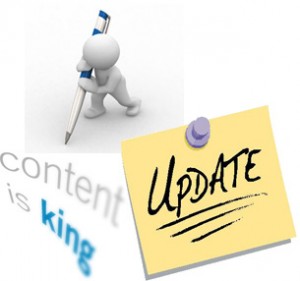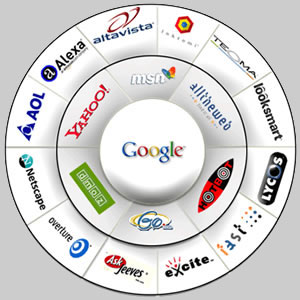June 28th, 2014 → 3:57 pm @ iowawebguy // No Comments
Yep. I said it. Sigh…
I always tell clients to keep their website content up-to-date. Keep it fresh. Keep it new!
(Okay, as you can see… I’m having a hard time finding time finding time to update this site too! So, going forward I am going to TRY to practice what I preach. I always say, “the shoe maker gets their shoes last…” BUT- that shouldn’t be an excuse…)
 There are many benefits to having updated content on your site, here are a few:
There are many benefits to having updated content on your site, here are a few:
How do we go about doing this?
I cannot stress enough how important a schedule is to website visitors. If you update your site often, they will come back and if it is on a schedule they will know what days to come get fresh content.
A couple examples to end:
Website statistics will also show you trends in your visitors. Most successful websites have their website content on a schedule.
Good Luck!
–Iowa Web Guy
September 27th, 2012 → 10:30 am @ iowawebguy // One Comment
Today I spoke to a class at Grand View University on the basics of web design and development.
We jumped into the elements of a web page, HTML (Hyper Text Markup Language) and CSS (Cascading Sheet Styles).
After explaining some basic HTML codes we jumped in actually writing a webpage from scratch in a text editor. We added headings, images, paragraphs, links and even embedded a Google Map.
Now that we had a basic webpage with no formatting, we styled the page by centering, added a background color, formatted headings and fonts.
Then we added an additional web page and applied the external stylesheet to both pages so we only had to change styles in one file, not every HTML file.
Finally, after learning the basics of HTML and styles, I brought the students to this blog and showed them how a WYSIWYG editor actually applies the HTML coding behind the scenes.
This is an example of how to add (embed) a Google Map in the HTML view.
After this class, I believe the students left with a greater understanding and appreciation in what goes into building a web site.
— Iowa Web Guy
March 6th, 2012 → 7:30 am @ iowawebguy // No Comments
Recently Facebook made a game-changing announcement requiring all business pages to change from their current layout to the new “timeline” layout by March 30, 2012. What does this mean?
 Cover Photos
Cover Photos
The new “timeline” layout really allows more control of the look and feel of your business page using a “cover photo”. The cover photo allows you to heavily incorporate your branding. Dimensions are 850 pixels wide by 315 pixels tall.
Facebook is restricting what can be in your cover photo. These items can NOT be in your cover photo:
Good Bye Default Landing Pages
The functionality of directing visitors to a “default” landing page or facebook app is GONE! No more “likegating” where you entice visitors to like you to see more content or offer opt-in promotions. Marketers are going to have to come up with new ways to incorporate Facebook into their strategy.
I think this really blows, as people were really using these landing pages to customize and interact with visitors.
Sticky and Starred Posts
A new feature is a “sticky” post, where you can pin a post to the top of your page. You can also change post dates as well as “star” a post to add more attention to a post.
Page Tabs
Page tabs have been moved from below the profile photo to under the “cover photo” and are limited to 4 spaces (one of which has to be “Photos”). Where before you could have unlimited space, you will really need to think hard about what tabs are important.
App Canvas Size
The appearance of apps has changed as well. They will open up outside your “cover photo” shell and be displayed on the page centered. The size has been increased to 810 pixels from 520 pixels wide.
GAME-CHANGER
These are game-changing to the latest craze of Facebook Business “Fan” Pages. A lot of money and marketing efforts have gone into developing custom apps and default landing pages by thousands of businesses and organization.
What are your thoughts on these changes? Will this affect your marketing plans and strategy utilizing Facebook?
— Iowa Web Guy
October 22nd, 2011 → 1:06 am @ iowawebguy // No Comments
I receive a lot questions from clients regarding emails they receive that ask for personal information. They usually call and say, “I just received an email and it wants to know my bank account and routing number. What do I do? Is this legit?”
 100% of the time these types of emails are SPAM and hackers or spammers use these emails to try to get YOU to give THEM your sensitive information. This is called PHISHING (like “fishing” for information).
100% of the time these types of emails are SPAM and hackers or spammers use these emails to try to get YOU to give THEM your sensitive information. This is called PHISHING (like “fishing” for information).
Due to the numerous types of e-commerce applications I write, we usually deal with credit card processing and NACHA files and when clients see those types of emails, they always catch their eye.
Banks, credit unions, credit card companies, and all other reputable companies will NEVER, NEVER, EVER ask for this information thru email.
Phishing does NOT stop with EMAIL. I’ve seen and experienced attempts thru the mail, phone, and other websites. Don’t take the bait. Sometimes it’s hard to tell. I’ve seen emails that have a link to a site that looks just like PayPal—I mean exactly like it. The only way to know is to look in the “address bar” of your browser to make sure it’s the actual site.
If you fall victim to Phishing, or *think* you fell victim, contact your financial institution immediately.
For more information on “Phishing” click here.
–Iowa Web Guy
September 12th, 2011 → 11:06 pm @ iowawebguy // No Comments
I was sitting with a new client today and one of the first questions she had was “Why do I have a lot of ‘empty space’ on each side of my web site?”
 I immediately thought, “I need to blog about this!” I get this question ALL the time when I’m talking with people when discussing web site layout.
I immediately thought, “I need to blog about this!” I get this question ALL the time when I’m talking with people when discussing web site layout.
The answer is a little complicated, but here we go:
What the heck does that mean?
Resolution:
As technology improves, computer monitors become bigger and allow for more display space (or number of pixels).
Design/Layout:
We design the webpage layout so it will display correctly for the majority of viewers. If a viewer has a larger monitor than the average, they will have the extra space. (The amount of extra space varies from computer monitor resolution to computer monitor resolution.)
The leftover space is the extra space on the sides of your web site!
How do you determine what resolution to target to minimize “extra space”?
I ALWAYS look at website statistics to help me make critical decisions. Here are some real statistics from this website.
As you can see, 93% of viewers have resolutions widths of 1024 or greater! So, 1024 is a safe number to target. 1280 would cover 90%!
Technology Changes…
Technology is ever evolving so these resolutions change all the time. Here is a chart of resolutions in 2008.
See the huge change in resolutions! 1024 went from 47% in 2008 to 4% in 2011. Wow!
Choose wisely!
If you choose too large of a resolution, a visitor that has a smaller resolution will have to SCROLL left and right to view the site! This is very annoying and NOT user-friendly.
–Iowa Web Guy
August 23rd, 2011 → 9:00 pm @ iowawebguy // No Comments
Every web site MUST have a “web host” so your site can be found on the Internet.
 What is Web Hosting?
What is Web Hosting?
Basically, web hosting is “leasing” disk space on a web server. This space is where your web site files and folders live for the world to view. The web server may also contain email and database hosting depending on your web hosting plan.
Why do I need a Web Host?
Web hosting companies have the facilities and resources to provide fast, reliable web hosting that many individuals and businesses do not have (expert staff, security, power back-up, multiple internet connections, back-up servers and parts, etc). Leasing web hosting space is very cost-effective with basic web hosting plans starting at pennies a day.
How does Web Hosting work?
Joe, a guy in Des Moines, Iowa, wants to visit a web site: www.google.com.
You could think of it this way:
Jane, a gal in Des Moines, Iowa, wants to send you (an Ames, Iowa resident) a LETTER in the mail.
Without your P.O. Box (or web hosting space) and the post office (or Internet), the letter would not be delivered to your address (or web site).
Geesh!
I hope that wasn’t too confusing. I tried to make a very complicated subject simple…
Check back for a future blog on how to choose a web host.
— Iowa Web Guy
August 15th, 2011 → 11:31 pm @ iowawebguy // No Comments
One of the most asked questions I receive is: “How can I get my website to rank high on Google?”
 This is obviously a very important question, so I’ll cover a couple basics:
This is obviously a very important question, so I’ll cover a couple basics:
Tip #1 – NEVER believe someone that can GUARANTEE a high page rank. While it’s possible, it’s impossible to guarantee. Google’s search algorithm is a secret, but they do give us some basic tips and hints on how the equation works.
Tip #2 – Focus on 5-7 of your best “search phrases” meaning what would your ideal target (the person you want to come to your web site) type into Google to find your site.
Tip #3 – Content is KING. Use the “search phrases” you’ve defined in Tip #2 as many times as possible when writing your website copy. Do NOT just dump them into your website, use them in sentence and paragraph form. Google can actually detect this and actually penalize you!
Tip #4 – Ditch the “Image Text“. I still see several websites that use graphics to display actual copy. I find people that want to do this when they can’t get the page to format correctly, or want to use a special font that isn’t supported on all computers. Google and other search engines CAN’T read the text in an image.
Tip #5 – Add a Sitemap and Robots file. If you don’t have them, you need them. These both instruct the search engines what to do with the pages of your website. Here is a link to a FREE Sitemap Generator.
There are other tips that I will cover in future blog posts. A good web strategy should define these search phrases and implement them successfully into your website.
If you have questions or need help with your search engine strategy, give me a shout!
–Iowa Web Guy
Blog &General &Questions &Search Engines &web development &Web Strategy
August 1st, 2011 → 6:51 pm @ iowawebguy // No Comments
 Welcome to IowaWebGuy.com!
Welcome to IowaWebGuy.com!So, I just had a flashback to my first programming tutorial. I’m pretty sure all developers, no matter your language of choice, completed the “Hello World” tutorial.
Anyway, enough about that and on to the blog! I’ve been consulting on all things web and all things development for several years. I’ve had a lot of help and learned a lot along the way. This blog is my way of giving back!
I’ve been wanting to start this blog for quite some time and I look forward to answering your questions and sharing information you may not even know you need.
Feel free to ask questions in the comments section if they relate to a particular post, or click the “Ask a Question” link on the homepage to ask a new question. I’ll try my best to respond promptly.
— The Iowa Web Guy